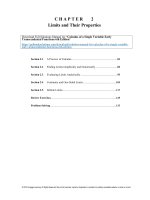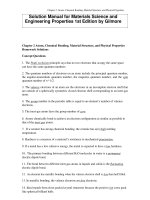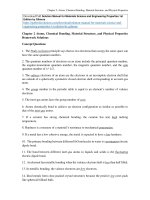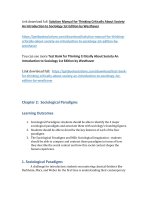Solution manual for comprehensive assurance and systems tool integrated practice set 2nd edition ingraham
Bạn đang xem bản rút gọn của tài liệu. Xem và tải ngay bản đầy đủ của tài liệu tại đây (58.74 KB, 5 trang )
Full file at />
INSTRUCTIONAL NOTES
CLIENT ACCEPTANCE:
The Winery At Chateau Americana
INSTRUCTIONAL OBJECTIVES
•
•
•
•
•
Understand types of information used to evaluate a prospective audit client
Evaluate background information about an entity and key members of management
Perform and evaluate preliminary analytical procedures
Make and justify a client acceptance decision
Describe matters that should be included in an engagement letter
KEY FACTS
•
•
•
•
•
•
•
Chateau Americana (CA) is a family-owned winery that is currently considering whether to hire a
new public accounting firm.
Current year sales - $21,945,000; net income - $1,997,000; total assets - $42,029,000.
CA operates a 125-acre vineyard which yields one-fourth of the winery’s production needs. CA is a
modest winery with annual production of 385,000 cases of wine.
The wine industry is a fragmented industry with more than 1,800 wineries in the United States.
Most key management positions are held by members of the Summerfield family. The exception to
this rule is Rob Breeden, the CFO.
The winery implemented a new accounting information system some fourteen months ago. There has
been some employee turnover as a result of the new system.
Discussions with the predecessor auditor, Harry Lawson, revealed no significant disagreements with
management; however, Mr. Lawson indicated that Rob Breeden was “more aggressive” than the
winery’s former CFO.
buy this full document at
Full file at />
SUGGESTED SOLUTIONS
1. Identify four to six procedures auditors may perform as part of the client acceptance process. Are
any of the procedures identified by you required by generally accepted auditing standards?
Auditors perform a wide variety of procedures prior to accepting a new audit client. The following are
examples of procedures that may be performed as part of the client acceptance process (Required
procedures are indicated by an asterisk). Please note that these procedures are not listed in a specific
order.
a. Determine the reason for the audit (e.g., compliance with debt covenants, regulatory
requirements, etc.).
b. Conduct a background investigation of the client and key personnel.
c. Determine whether the firm personnel have sufficient training and expertise to perform an audit
of the client in accordance with GAAS. *
d. Review available financial statements, minutes of board of directors’ meetings prior, tax returns
and other documents pertinent to the client’s operations.
e. Perform preliminary analytical review procedures to identify areas of high risk and to understand
the nature of the client’s financial statements.
f. Determine whether the firm is independent with respect to the client. *
g. Request the prospective client’s permission to communicate with the predecessor auditor. *
h. Communicate with the predecessor auditor and inquire about matters such as information that
might bear on the integrity of management, disagreements as to accounting principles, audit
procedures, or other significant matters, communications to the audit committee regarding fraud,
illegal acts and internal control related matters, and the predecessor auditor’s understanding as to
the reason for the change of auditors. *
i. Tour the client facilities to learn of the nature and scope of operations.
j. Evaluate the need for and availability of specialists. *
k. Obtain an understanding with the client regarding the services to be performed in the engagement
and document that understanding in written communication with the client. *
l. Assess the business risks of the CPA firm’s association with the prospective client.
2. Identify and discuss financial and non-financial factors that are relevant to the decision to accept
the potential client.
Student responses to this requirement will vary. The following is a partial list of the factors that are
likely to be relevant to the firm’s decision.
Financial Factors:
a.
CA has strong and upwardly trending sales and has been profitable for the last three years and
beyond as evidenced by the retained earnings balance.
b.
Although CA’s current ratio is below the industry average, its AR and Inventory turnover
compare favorably.
c.
The company’s debt load is lower than the industry average (debt-to-equity ratio for the
company is 0.52 compared to the industry average of 0.99). The company’s strong sales and
earnings have provided sufficient cash to cover debt and interest payments and produce a Times
Interest Earned measure above the industry average (9.41 compared to 6.91).
buy this full document at
Full file at />
d.
CA’s balance sheet appears to be strong with increasing current assets. Much of the increase
in the last year is in the company’s Investments and Production Inventories balances. In addition,
the company has invested more than $2,000,000 in productive assets in the last year.
e.
Accounts payable have increased by more than 35% since the prior year and long term debt
has increased slightly.
Non-financial Factors:
a. The company is considering an initial public offering in the near future.
b. The wine industry is a highly fragmented industry that is dominated by a small number of large
companies such as Ernest & Julio Gallo and Constellation Brands.
c. Wine distribution is primarily achieved through supermarket chains and mass merchandisers.
Other distribution outlets offer substantially less growth opportunity.
d. The wine industry appears to have a bright future and the industry, as a whole, has significant
growth opportunities in the US. Wine consumption is highest among adults 35-64 years of age,
the generation that tends to have the greatest amount of disposable income.
e. Significant consolidation has taken place in the wine industry and the trend is likely to continue.
f. CA has entered into exclusive distribution agreements with outlets in several large metropolitan
areas and is seeking similar opportunities in other areas.
g. The Summerfield family owns the winery and members of the family hold most management
positions.
h. Rob Breeden became the winery’s CFO just two years ago after the company’s CFO of more than
15 years resigned. There are rumors that the resignation was in response to disagreements
between the CFO and the president, Edward Summerfield, regarding the need for a new AIS.
i. The vice-president of winery operations, Jacques Dupuis, was accused of theft of trade secrets
form a former employer, but the charges were ultimately dropped due to insufficient evidence.
j. CA implemented a new AIS some fourteen months ago. The new system is fully integrated with
modules for purchasing and accounts payable, sales and accounts receivable, production and
inventory, payroll, and the general ledger. Each of these modules provides data that are critical to
the company’s operations. There has been some employee turnover due to continuing problems
with the AP and AR modules.
k. Discussions with the predecessor auditor indicate that there were no significant disagreements,
but the former partner-in-charge made the comment that Rob Breeden was “more aggressive than
CA’s former CFO.”
3. Perform preliminary analytical procedures using the financial statements provided by the client.
Calculate ratios for comparison to the industry averages provided and identify relationships or
areas that may be of concern during the audit.
Current Ratio
27,076 ÷ 7,082 = 3.82
Accounts Receivable Turnover
21,945 ÷ [(5,241 + 4,816) ÷ 2] = 4.36
Average Days to Collect Accounts Receivable
365 ÷ 4.36 = 83.72
Inventory Turnover
11,543 ÷ [(15,593* + 14,309) ÷ 2] = 4.36
* Includes production and finished goods
Company
Ratios
20XX
3.82
Industry Ratio
Averages
20XX
20XW
4.9
4.7
4.36
4.42
4.30
83.72
82.58
84.88
0.77
0.67
0.80
buy this full document at
Full file at />
Days in Inventory
365 ÷ 0.77 = 474
Assets to Equity
42,029 ÷ 27,718 = 1.52
Debt to Equity Ratio
14,311 ÷ 27,718 = 0.52
Times Interest Earned
3,386 ÷ 360 = 9.41
Return on Assets
(1,997 + 360) ÷ [(42,029 + 38,322) ÷ 2] = 5.9%
Return on Equity
1,997 ÷ [(27,718 + 25,721) ÷ 2] = 7.5 %
474
545
456
1.52
1.99
2.14
0.52
0.99
1.14
9.41
6.91
7.29
5.9 %
5.56 %
7.61 %
7.5 %
5.92 %
10.76 %
Ratios for CA generally compare favorably to industry averages. Certainly the company’s current
ratio is below the industry average, but it’s AR and inventory turnover measures compare
favorably. In addition, the asset to equity ratio is below the industry average and debt to equity is
lower than the industry average. The company is generating a higher return on profits and equity
than the industry. This also bears investigation. Notwithstanding the results from the analytical
procedures, areas that would generally be treated as significant include accounts receivable,
investments, inventory, accounts payable, and long term debt.
4. Based on the information obtained do you recommend that the firm accept or reject the potential
client? Prepare a memo that clearly outlines your recommendation and the basis for your decision.
Although there is no correct answer, most CPA firms would accept CA as a client. Student responses
should include discussion of the financial and non-financial factors identified in response to question
#2 above.
5. Identify matters that should be included in the engagement letter for this client. You may wish to
refer to SAS No. 108, “Planning and Supervision.”
Although auditors are required to obtain an understanding with their client, there is no requirement
that the understanding take the form of a written engagement letter. Nonetheless, most firms choose
to use an engagement letter to avoid confusion and to eliminate the risk that either party has
expectations that are inappropriate. The following are matters that should generally be included in an
engagement letter:
•
•
•
•
•
•
The objective of an audit is the expression of an opinion on the financial statements.
Management is responsible for the financial statements and is also responsible for establishing
and maintaining internal controls over the statements.
Management is responsible for identifying and ensuring that the company complies with all
applicable laws and regulations.
Management is responsible for making all financial records and documents related to the
financial statements available to the auditor.
A statement regarding the auditor’s responsibilities (i.e., conduct an audit in accordance with
GAAS, obtain an understanding of internal control, and to express an opinion on the financial
statements).
Management is responsible for adjusting the financial statements to correct material
misstatements and to provide written representation that the effects of uncorrected misstatements
buy this full document at
Full file at />
are immaterial to the financial statements.
Engagement letters may include other matters such as:
• Arrangements regarding the conduct of the engagement (e.g., timing of the audit, a list of
requested documents, etc.)
• Arrangements involving internal auditors and communications with predecessor auditors.
• Information related to billing and fees.
• Conditions under which access to the audit documentation may be available to others.
• Arrangements regarding other services to be provided in connection with the engagement (e.g.,
preparation of the entity’s tax return, audit of benefit plans, etc.)
buy this full document at









